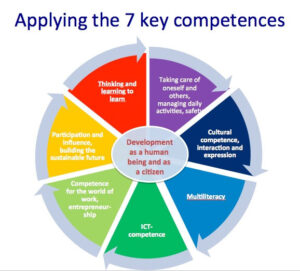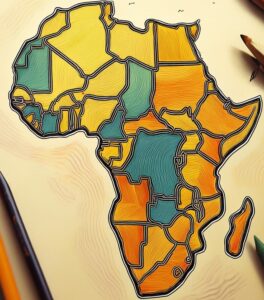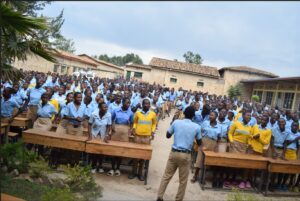By Jean Baptiste Ndabananiye
Suppose you educate nursery school pupils. You give them some pieces of clay and assign them to creating whatever they want. You will be astounded by works or objects that they will produce. Like that, education in the developed world is structured to immerse students in real-world problems, enabling them to critically analyze and seek practical solutions. Through project/phenomenon-based learning, interdisciplinary approaches, and innovative teaching methods; students not only understand concepts but also develop the ability to apply them in diverse contexts. This nurtures analytical and creative thinking, laying the foundation for a workforce capable of driving innovation and competing globally.

Conversely, generally in Africa, traditional education systems prioritize memorization and comprehension over deeper cognitive engagement. Students are often trained to regurgitate information rather than to question, analyze, and innovate. This approach limits the development of higher-order thinking skills essential for problem-solving, entrepreneurship, and global competitiveness. So, all Africa’s education should be inspired by the project-based learning model preparing children to become creators and entrepreneurs, rather than a system just grooming them to become job-seekers. All Africa’s education stakeholders like Association for the Development of Education in Africa (ADEA) and Mastercard Foundation ought to heed the model too in their work in Africa.
For Africa to build a strong and competitive workforce, this paradigm must shift. Education must cease to simply focus on understanding existing knowledge. Instead, it must spark students’ cognitive capabilities, guiding them through the cognitive hierarchy—from understanding to analyzing, evaluating, and ultimately creating. This will empower young Africans to become problem-solvers, innovators, and leaders in the global economy.
Examples on immersing students in problem-solving education
Finland
In Finland, students engage in phenomenon-based learning, where traditional subjects are replaced with interdisciplinary projects concentrated on solving real-world problems. For example, students explore the impact of climate change by studying scientific data, proposing sustainable energy solutions, and collaborating with local communities to implement practical measures.

Taylor& Francis Online is a platform— that hosts a vast collection of academic journals, books, and other scholarly content published by Taylor & Francis Group—, one of leading academic publishers in the world. It published a thorough article—with over 7500 words on Finland’s education system— entitled “Phenomenon-based learning in Finland: a critical overview of its historical and philosophical roots,” on 7 February 2024. The article reads “The idea of phenomenon-based learning (PhBL) was introduced into the Finnish core curriculum for basic education in 2014.
The Finnish approach has raised interest in many other countries. In Finland, the idea of PhBL is often linked to the traditions of educational psychology, constructivism, problem-based learning (PBL) and inquiry-based learning (IBL). ”
In its 29 May 2017 article, the BBC said “Finland has long been renowned for the quality of its education and always scores highly in international league tables. For nearly two decades, Finland has enjoyed a reputation for having one of the world’s best education systems. Its 15 year olds regularly score amongst the highest in the global Pisa, external league tables for reading, maths and science.
Its ability to produce high academic results in children who do not start formal schooling until the age of seven, have short school days, long holidays, relatively little homework and no exams, has long fascinated education experts around the world. Despite this, Finland is shaking up the way it is doing things – a move that it says is vital in a digital age where children are no longer reliant on books and the classroom to gain knowledge.”
The BBC reported that in August 2016 Finland obliged every Finnish school to teach in a more collaborative way. Its aim was to permit students to pick a topic relevant to them and base subjects around it. “Making innovative use of technology and sources outside the school, such as experts and museums, is a key part of it.”
Citing Kirsti Lonka— a professor of educational psychology at Helsinki University, the BBC added that the aim of this way of teaching – PBL – is to equip children with skills necessary to flourish in the 21st Century. Among skills she singled out figure critical thinking to identify fake news and avoid cyber-bullying, and the technical ability to install anti-virus software and connect to a printer.
Ms. Lonka said “Traditionally, learning has been defined as a list of subject matters and facts you need to acquire such as arithmetic and grammar. But when it comes to real life, our brain is not sliced into disciplines in that way; we are thinking in a very holistic way. And when you think about the problems in the world – global crises, migration, the economy, the post-truth era – we really haven’t given our children the tools to deal with this inter-cultural world.”

“I think it is a major mistake if we lead children to believe the world is simple and that if they learn certain facts they are ready to go. So learning to think, learning to understand, these are important skills – and it also makes learning fun, which we think promotes wellbeing.”
According to the BBC, Finnish schools bear unusual characteristics. “Teaching is a highly respected, well-paid profession. There are no school inspections or teacher evaluations. The school system is highly centralised and most schools are publicly funded. School days are short and the summer break is 10 weeks. Children are assessed by their teachers. The only nationwide exam is for those who continue studying to 18.
Average school size is 195 pupils; average class size is 19 pupils. Success has been attributed to a traditionally high regard for teaching and reading, as well as a small, largely homogenous population.”
Frontiers identifies itself as a leading research publisher, with its role being to provide the world’s scientists with a rigorous and efficient publishing experience. In its 19 January 2024 mini-review article entitled “Transcending traditional paradigms: the multifaceted realm of phenomenon-based learning”, Frontiers states “Phenomenon-based learning emphasizes direct engagement with everyday phenomena, highlighting how personal experiences influence our understanding of reality.”
Amid the evolving demands of the modern world, some nations have boldly reimagined education to meet 21st-century challenges head-on. Finland leads this charge with an approach that transforms classrooms into dynamic hubs of creativity and problem-solving, inspiring a global movement toward holistic and impactful learning.
Frontiers explains “Despite challenges, notably resistance from educators, Finland’s innovative strategies and commitment to high-quality education have been pivotal to its success. This transformation in teaching methodology diverges from traditional methods, endorsing a comprehensive skillset, innovation, and practical problem-solving. The adoption of this approach by various countries attests to its efficacy in fostering essential academic competencies. ”
“PhenoBL [Phenomenon-based learning] represents a paradigm shift, offering flexible, relevant, and interdisciplinary education. Success stories from countries like Finland, Thailand, Norway, and Vietnam demonstrate improved competencies in reading and critical thinking. This approach cultivates holistic skills such as problem-solving, innovative thinking, and metacognition, preparing students to address real-world challenges effectively.”
Finnish schools integrate life skills development into their curriculum by assigning projects like organizing community events, where students plan budgets, coordinate logistics, and reflect on their experiences, linking academic learning to societal contributions.
United States of America
The United States promotes project-based learning in schools through programs like STEM (Science, Technology, Engineering, and Mathematics) initiatives. For instance, students in robotics classes design and build machines to complete specific tasks, such as disaster relief drones, fostering technical skills, teamwork, and critical thinking. American high schools often host hackathons and coding challenges, where students collaborate to create applications or software solutions addressing issues such as mental health or environmental conservation, blending technical proficiency with problem-solving.

The National Math and Science Initiative (NMSI) is a non-profit organization based in Dallas, Texas, launched in 2007. Its mission is to improve student performance in the subjects of science, technology, engineering, and math (STEM) in the United States. In its 28 May 2024 story “How Project-Based Learning Transforms STEM Education”, it says “Project-based learning (PBL) is at the forefront of an educational revolution in teaching STEM (science, technology, engineering, and mathematics). The dynamic approach engages students and prepares them for real-world challenges. Project-based learning is a teaching method that starkly contrasts traditional rote learning.
Instead of passively receiving information, students actively engage in an extended investigation and response to a complex question, problem, or challenge. The hands-on, student-centered approach fosters a deeper understanding and prepares students for the complexities of the real world.”
This organization contends that PBL has produced a great impact on STEM education, enhancing engagement and retention, delivering concrete understanding, and providing real-world application. “Research on project-based learning (PBL) versus traditional teaching methods reveals numerous advantages. For instance, effective PBL bolsters long-term material retention and frequently leads to outcomes on major exams that are comparable to or better than those of students taught traditionally.
Additionally, PBL enhances problem-solving and teamwork skills and cultivates a more positive attitude toward learning. PBL leverages students’ inherent curiosity, which boosts their motivation and deepens their understanding of the material. In addition, all students, particularly those previously from schools experiencing lack of funding and external support, can experience the rich learning opportunities that students in elite environments have. Improving PBL-related practices among teachers could end the rule of rote learning and test prep schooling, which permeates many impoverished schools.”
The organization adds “Abstract concepts can often be challenging, particularly for younger learners. Hands-on activities help simplify complex scientific principles by transforming them into physical experiences. According to an article by the National Science Teaching Association, students who engage in hands-on learning develop a deeper, concrete understanding of scientific concepts. One of the most significant advantages of project-based learning is its ability to bridge the gap between theoretical knowledge and real-world application. This connection makes learning more exciting and shows students the practical utility of their academic studies.”
Various countries especially in the advanced world, are working to arm their children with modern skills, employing the PPB model. In Denmark, students participate in design thinking workshops, tackling problems like urban traffic congestion by brainstorming, prototyping, and testing solutions, emphasizing creativity and practical application. The UK encourages enterprise education through programs like Young Enterprise, where students run small businesses to solve market needs, learning about marketing, finance, and operations management hands-on.
Germany’s apprenticeship model enables students to work part-time in industries like automotive or IT while studying, enabling them to solve practical challenges under professional mentorship. In Canada, schools implement outdoor education programs, where students address ecological issues, such as restoring wetlands or preserving biodiversity, combining environmental science with hands-on action. Australian schools often integrate global issues into their curriculum, like sustainable agriculture. Students might create vertical gardens or water-saving irrigation systems, applying knowledge from biology, chemistry, and engineering. Singapore’s education system focuses on collaborative problem-solving, where students analyze case studies on topics such as urban housing challenges, brainstorm solutions, and present their findings to policymakers.
These examples highlight how the developed world primes students to think critically and act innovatively, equipping them for real-world challenges. Africa and even other parts of the world facing similar challenges ought to adopt the model. Yet Africa is particularly and especially required to do so. The entire world should intervene in it, since as we have addressed in various article like this one, the world expects Africa to provide a global workforce.
Africa education transformation

This section won’t consume much time, since areas to be improved in Africa’s education have been amply elucidated in the above section. To realize its education potential, Africa will deal specifically with the following key education aspects.
As for curriculum overhaul, Africa must also introduce project-based and inquiry-based learning that align education with real-world applications. This continent also needs to equip its educators with skills to foster critical thinking and creativity among the learners. A shift in pedagogy requires investment in teacher training, infrastructure, and access to modern tools and technology.
Africa also has to leverage digital tools to expose students to global knowledge and collaborative problem-solving platforms. African governments and stakeholders must therefore champion reforms that render education transformative rather than transactional. The governments need to prioritize education reforms that promote experiential learning, critical thinking, and problem-solving over traditional methods.
The word “transformative” refers to creating a deep, lasting change that fundamentally improves or reshapes something. It focuses on growth, development, and creating long-term impact. “Transactional” suggests interactions or actions that are more superficial or short-term, focused on exchanges or the completion of tasks without deeper or lasting effects.
By sparking cognitive engagement and creativity, African education systems will produce a workforce that not only competes globally but also drives sustainable solutions to the continent’s unique challenges.
The shift should incorporating local contexts, as it is implemented in various nations as already indicated. By grounding problem-solving in local contexts, African students too can tackle issues such as agriculture, healthcare, and infrastructure specific to their communities, fostering sustainable solutions.
Interdisciplinary learning constitutes another area to be considered in Africa. Developed countries often integrate STEM (Science, Technology, Engineering, and Mathematics) with arts and humanities to create a well-rounded curriculum. Africa can adopt similar models to prepare students for a variety of fields. Faster Capital constitutes a global online incubator and accelerator that helps startups in raising capital and offers technical and business development services. It clarifies interdisciplinary learning. “For example, a project that involves designing and building a wind turbine can be enhanced by incorporating art elements such as aesthetics and design. This approach can help students develop critical thinking skills and problem-solving abilities while fostering creativity.
The integration of humanities and arts in STEM education requires collaboration between different departments and faculty members. At WPI [Worcester Polytechnic Institute], interdisciplinary collaboration is encouraged and supported through initiatives such as the Great Problems Seminar. This course brings together students and faculty from different disciplines to work on real-world issues, such as climate change and healthcare.”
Faster Capital further says “The integration of humanities and arts in STEM education can help students understand the real-world applications of science and engineering. For example, a project that involves designing a prosthetic limb can be enhanced by incorporating elements of empathy and understanding of the patient’s needs. This approach can help students develop a more holistic approach to problem-solving and design.
The integration of humanities and arts in STEM education can help students understand the social and ethical implications of technology. For example, a project that involves designing a self-driving car can be enhanced by incorporating elements of ethics and responsibility. This approach can help students develop a more nuanced understanding of the impact of technology on society.”
Entrepreneurial mindset has to be cultivated among African students. A problem-solving approach fosters entrepreneurship, enabling students to create opportunities rather than just seeking jobs; which is vital in addressing high unemployment rates.
Reforming Africa’s education, to build a problem-solving workforce

Africa’s education system must undergo a radical shift to equip its youth with the necessary skills to thrive in a rapidly changing global economy. By embracing the innovative education strategies implemented in the developed world, Africa can cultivate a generation of problem-solvers, critical thinkers, and innovators. The developed world’s approach—focused on project-based learning, interdisciplinary methods, and the integration of technology—has proven successful in nurturing cognitive engagement, creativity, and practical problem-solving. These strategies not only enable students to understand concepts but also empower them to apply knowledge in real-world contexts, preparing them to tackle both local and global challenges.
In Africa, the traditional education system— which just often prioritizes memorization and understanding— limits the development of higher-order thinking skills. To transform Africa’s education landscape, the focus must move from merely understanding existing knowledge to fostering skills in analysis, evaluation, and creation.
This shift requires a comprehensive curriculum overhaul that incorporates project-based learning, inquiry-based approaches, and technology that connects students to global knowledge and problem-solving platforms. Furthermore, robust teacher training and infrastructure development are essential to enable educators to inspire creativity, critical thinking, and innovation in their students.
For Africa to build a competitive and globally relevant workforce, education must become a transformative process—one that empowers students to engage actively with the world around them. This involves grounding learning in real-world problems, with local contexts informing the solutions. By adopting these strategies, Africa can nurture leaders who not only contribute to global economic development but also create sustainable solutions to the continent’s unique challenges, such as those in agriculture, healthcare, and infrastructure.
In doing so, Africa will pave the way for a brighter future—one that is defined by innovation, creativity, and the ability to solve complex problems that affect both local communities and the global stage. With strategic investments in curriculum reforms, teacher development, and the integration of technology, Africa’s education system will form a powerful catalyst for the continent’s future success and even the world’s.
Thank you for this article! Great job done in contributing to reshaping educational system in Africa.
Appreciated.
I humbly appreciate your wonderful initiatives in Reforming African Education system for the 21st Century skills. This inspires me for sharing research experiences collaborating with developed countries in their education system and promoting industrial skills for selfreliance as suggested by Muhalimu Julius Nyerere Former President of Tanzania.
Dear Masereka Eric, thank you so much for your kind words. We’re truly humbled that our efforts resonate with you. It’s encouraging to know that the vision of reforming Africa’s education system for 21st-century skills inspires you as well. Together, through shared passion and collaboration, we can make a lasting impact for future generations